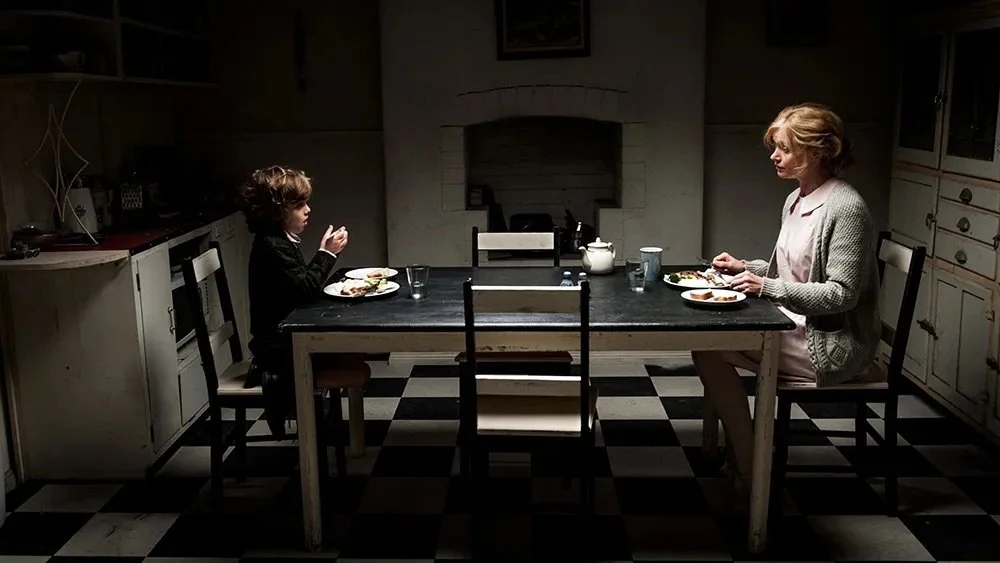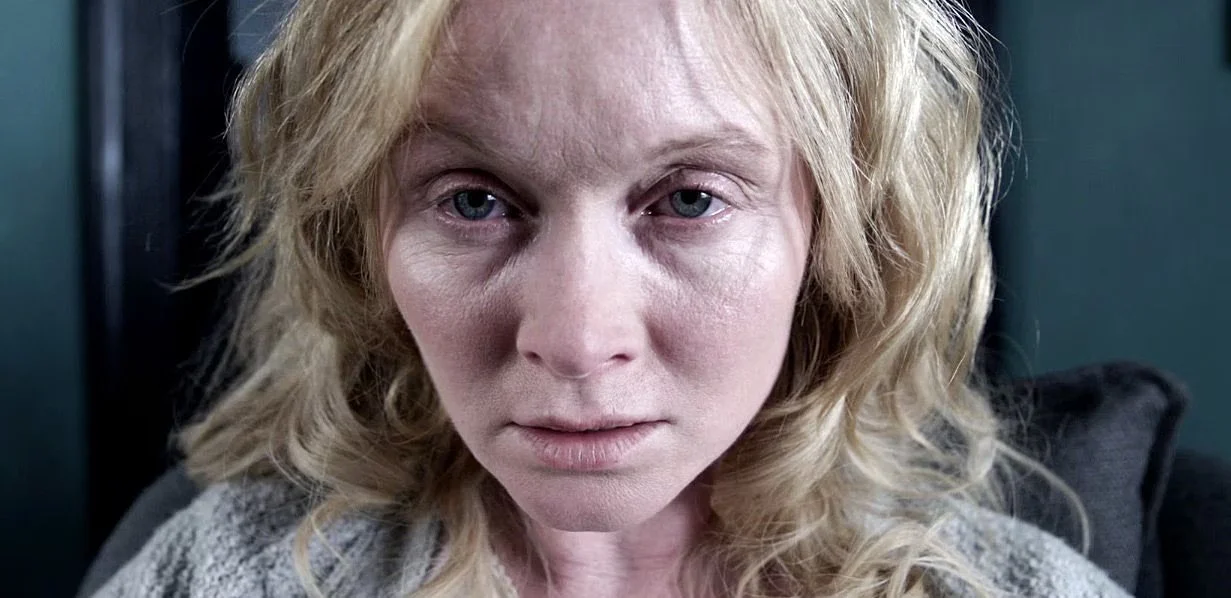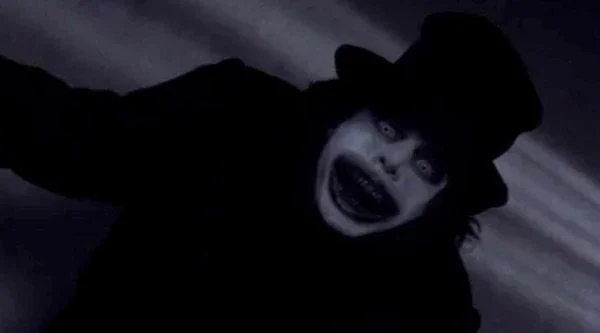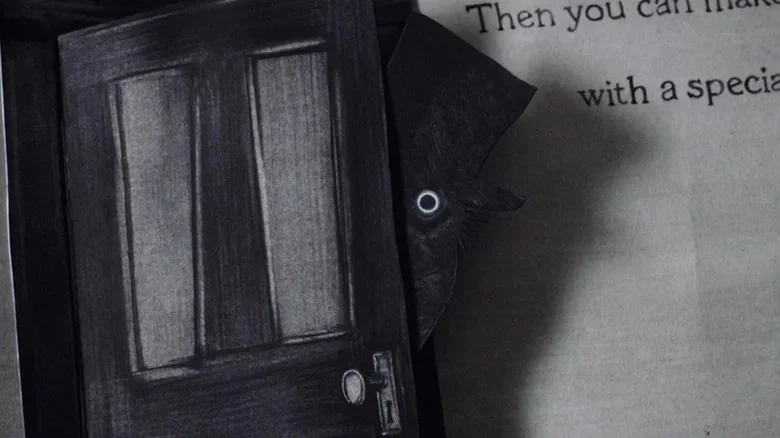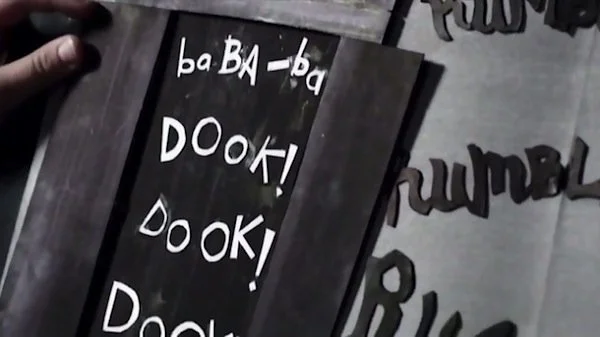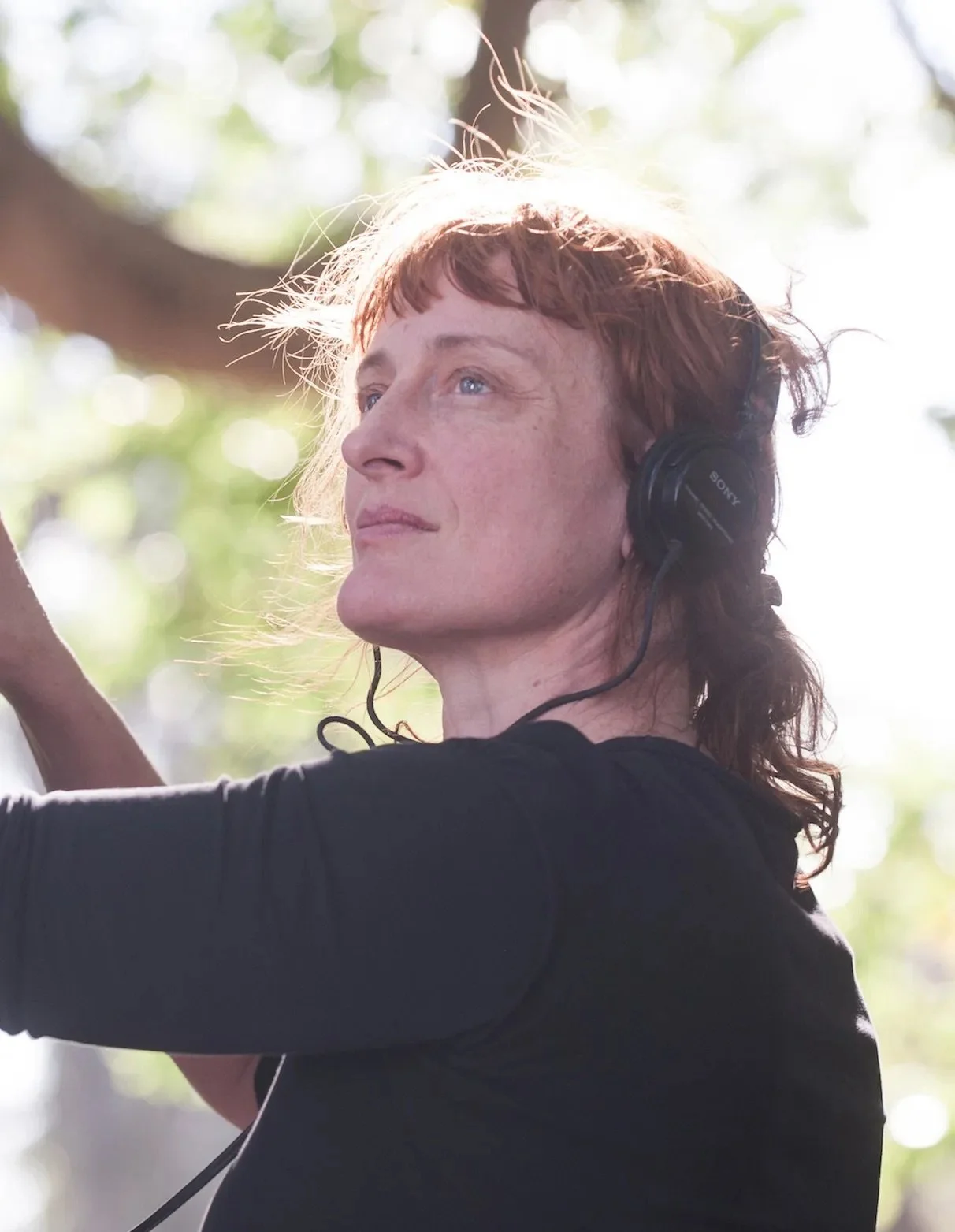You’ll See Him if You Look: The Babadook (2014)
Women’s History Month Series—four films, four killer directors
For this final installment of our women directors in horror series we turn to a film that snuck—or better yet, slithered—up on horror audiences back in 2014. This film touched a nerve and managed to resonate with both horror devotees and those who don’t typically consider themselves fans of the genre. We are of course referencing the supernatural chiller The Babadook, written and directed by Jennifer Kent.
Poster art
Born out of Tragedy
Children’s birthdays are typically associated with pure joy, childhood innocence, and unqualified parental love. For single mother Amelia Vanek (Essie Davis) and her imaginative if high-strung son Samuel (Noah Wisemen), birthdays are complicated and emotionally fraught occasions. We learn that Amelia’s husband was killed in a violent car crash while taking Amelia, pregnant with Samuel, to the hospital. Nearly seven years after this devastating event, we observe Amelia negotiating a life of single parenting that she never conceived for herself.
As many single parents can attest, being the sole caregiver has its shares of significant challenges even under the best of circumstances. Unfortunately for Amelia, her circumstances are far from ideal. She is perpetually sleep deprived as Samuel struggles with monster-filled nightmares on a regular basis. Amelia also grapples with deep-seated pain, anger, and unresolved trauma after the crushing loss of her husband. What makes her situation even more challenging are Samuel’s social and behavioral problems at school. He has difficulty fitting in with his peers and is often running afoul of teachers and administrators alike.
Checking for monsters
Amelia works as a nursing home aid, and is often called away from work to deal with problems that Samuel is having at school. Her sister Claire, and Claire’s (frankly) bratty and spoiled daughter are not a source of familial support. Claire is often frustrated and impatient with Amelia, eventually telling her that she can’t stand being around her son. The one source of reliable support is next-door neighbor Gracie, a warm, thoughtful, and kind older woman with Parkinson’s who seems to have a special bond with Samuel.
“If it's in a word, or if it's in a book you can't get rid of the Babadook.”
One night Samuel selects Mister Babadook, a new book that suddenly appears on his bookshelf, for his bedtime reading. Ostensibly a children’s pop-up book, Mr. Babadook features text and illustrations that are initially playful but become increasingly eerie and downright menacing the farther one reads. At the center of the story is a figure clad all in black and donning a top hat. The terrifying images frighten Samuel and Amelia decides to shelve the book. But because this is a horror film, disposing of the Babadook is not so simple. The nightmarish character begins to haunt and torment Samuel, who does his best to fend off this malignant force.
Reading Mister Babadook
Samuel continues to talk about the as yet unseen Babadook, but his warnings remain unheeded and in fact only frustrate his mother. Any attempt by Amelia to find a moment’s reprieve is thwarted by circumstances surrounding Samuel’s torment. It isn’t long, however, before Amelia begins receiving visits from the Babadook, who announces his presence via three knocks and the titular monster’s refrain “BABA…DOOK…DOOK…DOOK..” Amelia also begins to catch glimpses of the black figure as it lurks in the shadows. Her attempts to hide, discard, and destroy the book prove ineffective; in fact, with each reappearance of the book she finds new pages that are increasingly threatening and violent.
“Don’t let it in!”
It is now clear that this malevolent entity intends to terrorize, wear down, and take possession of Amelia when she is at her most vulnerable. The Babadook will stop at nothing to destroy her and Samuel through whatever diabolical means it has at its disposal: fear, guilt, and emotional manipulation. Meanwhile Samuel pleads with Amelia not to “let it in,” as he seems to have an intuitive sense of the Babadook’s power and what’s at stake for himself and his mother.
The film builds to a harrowing and heart-wrenching final third act, the details of which I won’t spoil here. Suffice to say, the finale is frightening, visceral, and emotionally exhausting, asking the viewer to consider what it means to vanquish vs. live with your demons.
Amelia facing her demons.
My two cents
I found The Babadook to be just as powerful in a recent re-watch as when I first saw it 10 years back. It admittedly takes the audience to some very dark places, both in the figurative and literal sense. Jennifer Kent pulls no punches, providing an unflinching portrayal of how trauma and pain can linger and fester if left untreated.
You can think of the Babadook as a metaphor for depression and trauma or you can view it as some kind of boogie man, a supernatural entity, a very real monster, or a combination of all of these. I tend to think of the Babadook not as a figment of Samuel or Amelia’s imagination but as some kind of malignant supernatural force that feeds off their pain, emotional turmoil, and especially Amelia’s repressed rage and resentment. In that sense, it is like Pazuzu in The Exorcist, a demon that will do all that it can to bring you to your knees then strike with impunity.
While I consider this to be a horror film through and through, it is also a story about mental health and the challenges of parenting. My wife and I have a six-year-old daughter, who is the center of our world. We are two reasonably well-adjusted parents of a wonderfully bright, social, and empathetic child. And while we feel incredibly fortunate, there are times when we have our fair share of struggles: not enough time to ourselves, feelings of burnout, and of course the financial strain of supporting a child in this crazy economy—and that’s with two of us doing the work. We can relate, even if to a fraction of a degree, to Amelia’s struggles as she tries to put her best parenting foot forward while hopelessly exhausted. Regardless of circumstances, I imagine most parents grapple with feelings of inadequacy. Watching this film, I am reminded of just how incredible and strong single parents are; they deserve so much more credit than society gives them.
Essie Davis is spectacular as Amelia; her unrelenting sleep deprivation, frayed nerves, lingering emotional trauma, and untreated depression are a visceral experience for the audience. In one particularly stark and raw moment, Amelia lashes out at Samuel out of frustration and pure exhaustion. This scene touched an emotional nerve for me as I suspect it did for other parents. As Yassmeen once said, you just want to wrap her in a blanket and tell her it will all be ok, and then reach for Samuel and doubly reassure him. Davis’s performance is so honest and so real to the point of making us uncomfortable. She is also downright scary in those moments when the Babadook seems to have possession of her, her voice and manner shifting to embody pure rage and uncontrollable grief. Davis does not hold back in this film, and I truly appreciate that in her performance.
Equally impressive is Noah Wiseman as Samuel; he tugs at your heartstrings as a child who struggles with socialization but is also curious, creative and empathetic. Samuel loves to watch his well-worn DVD tutorial on becoming a magician and even tries out his tricks with Amelia. There is a devastating dynamic between them as Samuel clearly yearns for his mother’s love while being attuned to her ambivalence about him and their life together. As events unfold, Samuel is placed in the position of having to protect himself and his mother from the Babadook. This is a very complex role for such a young actor: Samuel can be shrill and grating, but is also open-hearted, honest, and compassionate. Wiseman captures the many facets of Samuel’s character with an unguarded and raw approach, and it’s hard to believe that someone so young can deliver on a role the way that he does.
The design team and cinematographer were very successful at capturing the deep claustrophobia and darkness of the story. Much of the film takes place in the two-level Vanek house, the interiors of which set the tone with muted blues, cold grays, and very little contrasting color. It is one of the most subdued looking haunted houses you will find in cinema, but it works incredibly well in mirroring Amelia’s own troubled psyche and physical depletion. Shadows are very important to this story, as the Babadook lingers just out of the light in dark corners, doorways, and closets. While the full reveal of a monster can be very exciting, I think many would agree that a monster partially hidden and obscured is effectively scary and leaves more to the imagination.
Kent and her team were inspired by elements of German expressionism, channeling the aesthetics of classic horror movies of the silent era, including The Cabinet of Dr. Caligari (1920) and Nosferatu (1922). A great example of this is the design of the titular monster with its now-iconic top hat, overcoat, spindly fingers, and pale white face. There are virtually no clear, direct shots of the Babadook. Instead, we only get fleeting glimpses of him shrouded in shadow and darkness as he clings to ceilings and walls. While he is most often presented as a human-like monster, he is also a shape shifter, at times sprouting tentacles, claws, a tail, and even something resembling wings. The film also infuses surreal, macabre, and fantastical early silent film imagery that reflects Amelia’s often delirious and hallucinatory state of mind.
While this film was shot on a modest budget, Kent was smart to eke out as much atmosphere and dread from the sound design. The Babadook’s voice, guttural growls, snarls, and eerie slithers are the stuff of nightmares. On top of that the monster’s appearances are accompanied by these insect-sounding reverberations that will make your skin crawl.
Mister Babadook, the “children’s” pop-up book is that sets our horror story in motion, is wonderfully rendered in charcoal-colored drawings that conjure the specter of something that will reach out of the darkness and grab you. The book, designed and illustrated by Alex Juhasz, also features the heavy influences of German expressionist cinema.
The front cover of “Mister Babadook”
Trigger warning – Both animals and children (namely Samuel) are put very much in harm’s way, which could disturb some viewers.
About the director
Jennifer Kent on set
Australian writer/director Jenifer Kent started out as an actor, working in Australian television, while occasionally picking up some small film roles throughout the 1990s. She eventually lost interest in acting and decided to pursue directing instead. In 2006 she wrote and directed the short film Monster, which garnered a lot of attention at dozens of film festivals. This short would eventually be fleshed out to a full-length feature titled The Babadook.
Kent’s films often deal with topics surrounding parenting. In interviews she talks about the role of motherhood, often held as sacrosanct by society which inevitably contributes to the weight of unrealistic expectations of women. Kent discusses taboos related to motherhood, her horror film influences, and other topics in two noteworthy interviews. The first was published by Den of Geek back in 2014 upon the initial release of The Babadook with and the other was published by Collider in 2022.
Kent followed up The Babadook with The Nightingale (2018), a thriller and revenge tale that takes place in 19th-century Tasmania. It delves into themes of racism, motherhood, and the ravages of colonization. I can attest that the film is not an easy watch with content that includes racial and sexual violence. It premiered at the 75th Venice International Film Festival, where it was nominated for the Golden Lion.
Kent also directed the final episode of the horror anthology series The Cabinet of Curiosities (2022), created by writer/director Guillermo del Toro. That episode, “The Murmuring,” pairs her again with Essie Davis, who costars with Andrew Lincoln, best known for playing Rick Grimes on The Walking Dead. It is an eerie and moving tale centering motherhood and loss.
In the fall of 2024, I had the good fortune of attending a 10-year anniversary screening of The Babadook at the Museum of the Moving Image here in Astoria, Queens. Jennifer Kent gave a wonderful interview where she talked about her career and love for horror cinema. She was warm and quite down to earth. At the screening, she also talked about being approached to make a sequel to The Babadook. While she joked that such a follow up would have netted her quite a paycheck, the idea seemed ill advised and not something worth pursuing. However, she did reference (albeit vaguely) an upcoming project inspired by a well-known horror writer who is not Stephen King. I can’t wait to see what she has in store for us.
Lastly, some of you might be familiar with the Criterion Closet, whereby filmmakers and actors are invited by the boutique film restoration and distributor Criterion to a walk-in closet full of physical media. Guests spend a few minutes picking out movies (Blu rays, UHDs, and DVDs) to take home, while also talking about the films they love. Check out Jennifer Kent’s visit to “the closet” here, which coincided with her trip to New York to celebrate the 10-year anniversary of the film.
While this piece closes the book on this year’s Women’s History Month series, I am pleased to say that we are not done discussing horror films directed by women—not by a long shot. There are more than a few memorable horror entries yet to explore in this category, including Mary Lambert’s Pet Cemetery (1989), Ana Lily Armipour's A Girl Walks Home Alone At Night (2014), Arkasha Stevenson’s The First Omen (2024), and Amy Jones’ The Slumber Party Massacre (1982).
10th Anniversary re-release poster
Did you know?
Jennifer Kent and Essie Davis knew each other pre-Babadook, as both were students at the National Institute of Dramatic Art in Australia.
For scenes in which Amelia is verbally abusive towards Samuel, Kent had an adult stand in for Wiseman(kneeling down for perspective) as Essie Davis unleashed particularly hateful diatribes.
In the mid-to-late 2010s, The Babadook enjoyed the status of a queer icon, representing a fascinating turn of events in pop culture. Learn how it all happened in this 2017 New Yorker piece.
The film’s climax includes brief but very clear nods to horror classics such as The Exorcist (1973) and Poltergeist (1982). Fans of those films will have no trouble spotting them.
The film was rereleased in theaters in 2024 for its 10th anniversary.
I love a good movie within a movie reference and Kent treated us to a couple in The Babadook. We get fleeting glimpses of Carnival of Souls (1962), and a snippet from Amelia’s insomniac viewing session of Mario Bava’s anthology classic Black Sabbath (1963). Kent has cited the latter as one of the formative films that helped spark her interest in horror.
How did I watch?
10th Anniversary Blu-ray IFC Films
Also streaming on Shudder
Cast (abridged)
Essie Davis – Amelia Vanek
Noah Wiseman – Samuel Vanek
Hayley McElhinney – Claire
Daniel Henshall – Robbie
Barbara West – Gracie Roach
Ben Winspear – Oskar Vanek
Craig Behenna – Warren Newton
Chloe Hurn – Ruby
Tim Purcell – the Babadook
Crew (abridged)
Director & Writer – Jennifer Kent
Production Designer – Alex Holmes
Sound Designer – Frank Lipson
Director of Photography – Radek Ladczuk
Costume Designer Heather Wallace
Book Design and Illustration – Alex Juhasz
Music – Jed Kurzel
Producers – Kristina Ceyton, Kristian Moliere
Distributor – IFC Films
Production Companies – Causeway Films, Entertainment One, Smoking Gun
Running Time: 1h 34m
Recommendations based on The Babadook-
The Exorcist (1973)
The Amityville Horror (1979)
The Shining (1980)
Paranormal Activity (2007)
The Witch (2015)
Supplements-
Q&A: Actress Essie Davis Holds Her Own Against THE BABADOOK (Fangoria)






